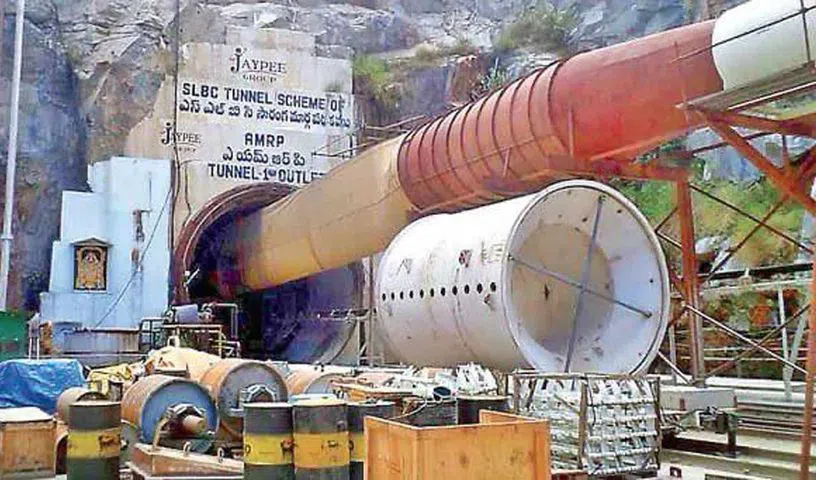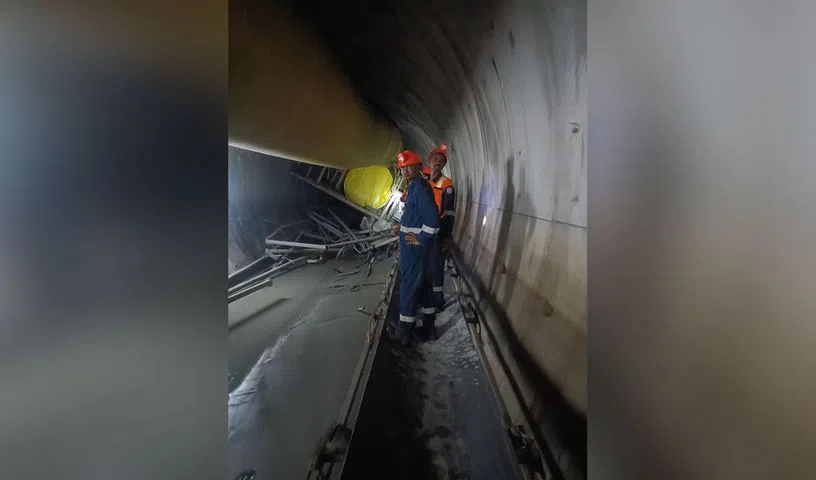Srisailam Left Bank Canal Tunnel Collapse: Tragedy in Telangana
Eight workers are trapped. A tunnel collapses. Can they be saved? The Srisailam Left Bank Canal (SLBC) project, a crucial lifeline for drought-prone regions, has turned into a site of despair and urgency. The collapse of the tunnel has raised serious concerns about safety measures in large-scale infrastructure projects. This article delves into the SLBC project’s significance, the factors leading to the tunnel failure, the ongoing rescue efforts, and the broader implications of this disaster.
The Srisailam Left Bank Canal Project: A Lifeline Deferred
The SLBC project was envisioned as a game changer for water-scarce areas in Telangana. Originally designed to transfer water from the Krishna River to dry lands, the project was seen as a beacon of hope for farmers and local communities. However, what was supposed to be a solution to water scarcity has now become the center of a tragic accident.
History and Objectives
The concept of the SLBC project dates back to 1983. It was planned to bring water to the parched lands of the Nalgonda district, which has suffered from persistent drought conditions. The primary goal was to irrigate 300,000 acres, ensuring better agricultural yields and improved livelihoods for thousands of farmers.

Project Timeline and Delays
Despite its noble objectives, the project faced numerous hurdles over the years. Financial constraints led to delays, and administrative inefficiencies further complicated matters. The bifurcation of Andhra Pradesh and Telangana in 2014 added another layer of complexity, as resources and responsibilities were divided. Construction firms like Jayaprakash Associates and Robbins Company were brought in to work on the tunnel system, but progress was slow and riddled with challenges.
The Tunnel System: Inlets and Outlets
The SLBC project consists of two key tunnels. The first tunnel is designed to transport water from the Srisailam Reservoir to the Dindi Balancing Reservoir. This tunnel, which spans several kilometers, is central to the project’s success. However, it is also where the disaster unfolded, raising serious questions about construction quality and safety standards.
Understanding the Tunnel Collapse: A Sequence of Events
The tunnel collapse was not a random event—it was the result of multiple factors converging over time. To understand what happened, we need to break down the sequence of events that led to the disaster.
The Shear Zone Encounter
A major challenge in tunnel construction is navigating geological obstacles. The SLBC tunnel encountered a “shear zone”—a section of rock that is fractured and unstable. These zones are notorious for causing disruptions in tunnel boring operations. Around 13 km into the tunnel, workers hit such a zone, which made excavation extremely difficult and dangerous.
Water Seepage and Mitigation Efforts
Water seepage is a common issue in tunnels, but the volume of water encountered in the SLBC tunnel was alarming—around 8,000 liters per minute. Engineers had to halt drilling operations in 2021 to address the problem. Despite their efforts, a critical portion of the shear zone, about three meters, remained unexcavated when work resumed.
The Day of the Incident: February 2024
When drilling restarted, the structural weaknesses in the tunnel became apparent. The roof of the tunnel collapsed, trapping eight workers inside while 52 others managed to escape. This incident has now sparked urgent rescue operations and a broader debate on construction safety and accountability.
Rescue Operations: A Race Against Time
With eight workers trapped underground, rescue teams are racing against time to save them. The operation is fraught with challenges, but authorities are deploying every possible resource to ensure a successful outcome.
Immediate Response and Challenges
Local authorities, the National Disaster Response Force (NDRF), and the Indian Army’s Engineering Task Force (ETF) responded swiftly to the crisis. However, the rescue efforts have been hindered by debris, mud, and ongoing water seepage, making it difficult to reach the trapped workers.
Rescue Techniques and Equipment
Rescue teams are utilizing specialized equipment, including:
- High-powered excavation machines to remove debris safely
- Underwater scanners to assess conditions inside the tunnel
- Industrial-grade pumps to control water levels
Efforts are also being made to restore electricity inside the tunnel, which would enable better coordination with the trapped workers.
Government and Expert Involvement
The Telangana Chief Minister and the Prime Minister have both taken an active interest in the rescue mission. An internal committee has been formed to investigate the collapse, and assistance is being sought from central agencies to expedite the rescue process.
The Human Cost and Broader Implications
Beyond the technical and logistical aspects, this disaster carries a significant human toll. Families of the trapped workers are anxiously awaiting news, while local communities are grappling with the uncertainty surrounding the project’s future.
The Trapped Workers: A Psychological Perspective
Being trapped in a tunnel with limited air, water, and communication is a terrifying experience. Psychological stress is a major concern in such situations, as seen in past incidents like the Chilean miners’ rescue. The mental well-being of the trapped workers is as important as their physical rescue.
Impact on the Region and Project Future
The SLBC project is critical for Telangana’s water security. The tunnel collapse threatens to delay the project further, potentially escalating costs and prolonging water shortages in affected regions. Villages that depend on the project’s completion now face an uncertain future.
Accountability and Future Safety Measures
Was this tragedy preventable? Investigations will determine whether negligence, engineering flaws, or geological miscalculations played a role. Regardless, the incident underscores the need for stricter safety regulations in tunnel construction. Future projects must incorporate advanced geological assessments and real-time monitoring systems to prevent similar disasters.
Conclusion
The Srisailam Left Bank Canal tunnel collapse is a stark reminder of the risks associated with large-scale infrastructure projects. While the immediate priority remains the rescue of the trapped workers, this disaster also demands a long-term reassessment of construction practices and safety protocols. Lessons must be learned, and stronger regulations must be enforced to ensure that such tragedies do not happen again. The people of Telangana deserve a future where development does not come at the cost of human lives.
